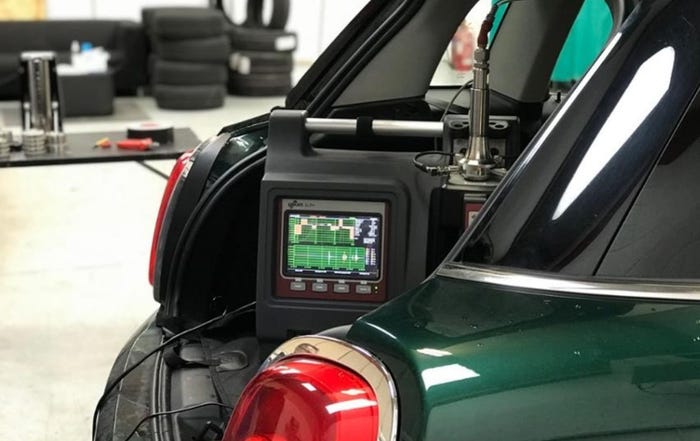Ford’s Gran Torino Relives Muscle-Car Heyday
In the Clint Eastwood film “Gran Torino,” Ford retiree Walt Kowalski’s cherished muscle car represents a time that has passed him by.


Clint Eastwood’s hit movie “Gran Torino” is resurrecting interest in a Ford Motor Co. midsize car that goes back 40 years.
The Torino nameplate debuted in 1968, and an all-new version called Gran Torino hit showrooms four years later. Before its run ended in 1976, replaced with the LTD II, Ford sold more than 1.1 million.
“Gran Torino” is not the car’s first cinematic role. A bright red ‘74 model starred in the “Starsky and Hutch” TV series during the 1970s. To add pizzazz, the TV coupe sported a large white stripe resembling the Nike logo that stretched from the front fender to behind the rear window.
In 1976, Ford built 1,000 “Starsky and Hutch” replicas, and the car’s role was reprised in a 2004 S&H movie starring Ben Stiller and Owen Wilson.
Eastwood produced, directed and stars in the new Warner Bros. movie, which has become his highest grossing film ever. The movie also has been praised by critics but failed to receive an Oscar nomination.
Eastwood plays Walt Kowalski, who owns a ‘72 Gran Torino Sport stashed in his garage in Highland Park, MI (the movie was filmed in the Detroit area).

Clint Eastwood stars in “Gran Torino.” Poster courtesy of Warner Bros.
The car is painted green with a gold “laser” stripe down the side and has a black vinyl “Sports Roof,” hood scoop and mag wheels – all the trimmings of the “muscle” cars popular in the late 1960s and early 1970s.
A Korean War vet, Kowalski worked 30 years on Ford’s assembly line stuffing steering gear boxes into vehicles, including his cherished Gran Torino.
Like his car, Kowalski is a product of another time in America, and the clash between the past and present is the movie’s central theme.
White and Catholic, he remains a holdout in a neighborhood that has been taken over largely by Hmong families who emigrated to the U.S. following the Vietnam War.
The Hmong are “hill people” who live in Cambodia, Laos and China but maintain their own distinct culture.
Kowalski is an equal-opportunity bigot, who initially has nothing to do with his Asian neighbors. “Keep off my lawn,” he snarls with his best Dirty Harry glare.
The Gran Torino comes into play when a young Hmong boy, dared by his cousin, makes a feeble attempt to steal the car. Kowalski catches him but eventually comes to like the boy and his family.
The Torino name first appeared in 1968 on the upscale version of the Fairlane midsize car. But by 1970 Torino became the primary name and in 1971 the Fairlane moniker was dropped.
The aerodynamics of the special-edition Talladega Torino helped Ford dominate the NASCAR circuit in the late 1960s and early 1970s. Ford offered the street-legal, high-performance cars, named for the famous Alabama racing venue, but only 743 were built. The vehicles remain valuable today.
Natalie Neff, road-test editor for AutoWeek magazine, rescued an old Torino from the scrap heap and intended to restore it, but got rid of it years ago. She loved the original Torino.
“It was a slightly smaller, lighter car, I believe, and put out real horsepower, especially in its Cobra Jet and Super Cobra Jet iterations,” Neff says. “It also was the NASCAR car, which the Plymouth Superbird and Dodge Daytona were designed to go up against.”

Ford Gran Torino made famous by “Starsky and Hutch” TV series.
Neff considers the original Torino much better looking than Kowalski’s ride of choice.
The Gran Torino featured a new design and remained in production until 1976 when the series was discontinued, in part the victim of increasingly stiffer federal safety and emissions regulations.
The 1973 oil embargo also dealt a blow to cars like the Gran Torino when powered by big gas-guzzling V-8s.
Although Gran Torinos have never elicited widespread collector interest, there are at least three clubs of aficionados based in New York, Las Vegas and Tennessee. Even enthusiasts concede the cars were prone to premature rust, peeling paint and durability problems.
The Torino nameplate pays homage to the city of Turin, often called “The Detroit of Italy” and home to Fiat SpA and famed coachbuilders Pininfarina SpA, Bertone SpA, Ghia SpA and Italdesign Giugiaro SpA.
“Gran” means “great.” The Torino moniker originally was considered for the Mustang but thankfully didn’t make the cut.
Kowalski’s Gran Torino is a 2-door fastback. But during its 8-year run, the Torino also was offered in up to 19 models, including convertibles, 2-door hardtops, 4-door sedans and station wagons.
The ‘72 sported a long hood and short rear deck, egg-crate grille and flared fenders front and rear. Only nine models remained, down from 14 in 1971, and the 7.0L “Cobra Jet” high-performance V-8 introduced in 1968 was dropped.
Still, six engines were offered, starting with a 4.1L inline-6 and five V-8s ranging up to 7.0L, and an upscale “Elite” version was added in 1975. A “Police Interceptor” 4-door featured a new 460-4V (7.5L) V-8 starting in 1973.
Ford switched from unibody to body-on-frame construction for 1972, a step some critics decried as backward. The auto maker claimed the layout provided a quieter and more isolated ride. The Gran Torino’s “Coke bottle” styling made it look heavier than it actually was. Curb weight ranged from 3,269-4,042 lbs. (1,528-1,833 kg).
The Gran Torino received generally good reviews in automotive buff books, but Eastwood’s movie has elicited some unbridled criticism.
Dan Neil, automotive critic for the Los Angeles Times, writes the Gran Torino was “one of many million overfed, undersprung and largely unlamented muscle cars” that poured out of Big Three plants.
“The car was tubby, and it was awkward,” Neil continues. “It handled like a block of ice with a steering wheel.”
AutoWeek’s Neff agrees with Neil’s assessment of the Gran Torino. “It was not a great car, mostly because it came out when horsepower was dialed waaaaay back,” she says. “It was the era when big blocks were putting out 150 hp.”
Neil blames both “Ford’s penny-chiseling management for the Gran Torino’s mediocrity,” as well as union assembly workers of that era.
Neil also suggests Detroit’s failure to compete four decades ago with the flood of Japanese imports, while pawning off cars like the Gran Torino on American car buyers, is what precipitated the Big Three’s current brush with bankruptcy.
Kowalski likely would disagree. “Get off my movie set,” he might menacingly growl.
About the Author
You May Also Like
_201.jpg?width=100&auto=webp&quality=80&disable=upscale)
_201.jpg?width=400&auto=webp&quality=80&disable=upscale)



